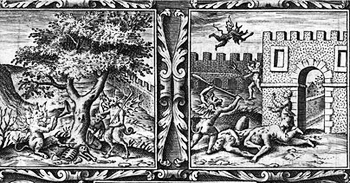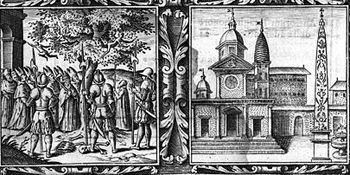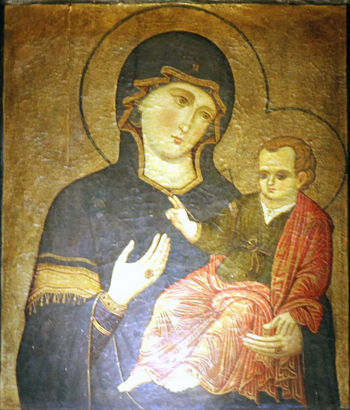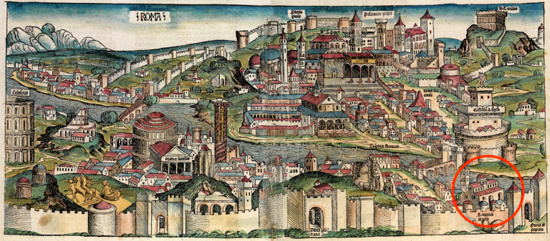Stories & Legends
 |
 |
 |
 |
 |
 |
 |
The Haunted Hill of Rome
Among the chastisements that have fallen heavy on man there are few greater than the long reign of tyrants. When these wretches have been hurled from their thrones and flung into dishonored graves by the sedition of an outraged nation, loud and long rises the grateful shout to Heaven from the liberated victims of oppression.
"The tyrant is dead !" rings from city to hamlet, and seeks with joyful echo the trembling refugee in seclusion and exile.
But at times God permits that their death does not stay the power to do evil, when from their tombs they are still permitted to molest the human race. History gives us a thrilling instance.
 Long before Rome was transformed into a center of artistic and cultural influence in the 15th century Renaissance, the city had a more rustic air with its rambling roads and green hills where sheep gamboled. There, at the northern gate of the city was a large walnut tree, which stood near the Collis Hortulorum, or Pincian Hill.
Long before Rome was transformed into a center of artistic and cultural influence in the 15th century Renaissance, the city had a more rustic air with its rambling roads and green hills where sheep gamboled. There, at the northern gate of the city was a large walnut tree, which stood near the Collis Hortulorum, or Pincian Hill.
The site was held in horror by the people. At night the deserted plain surrounding it rang with unearthly sounds, and horrible phantoms reveled around the solitary tree. The spirits assumed the most hideous form: Large, ugly ravens gathered on the branches of the tree and spoke with human voices.
For centuries this haunted spot was the terror of the Roman people. Many a thrilling, hair-standing tale of ghosts and frightful apparitions that infested the area surrounding the cursed nut-tree was handed down from father to son, and told around firesides.
Even bodily injuries were inflicted on those who, through curiosity or bravery, attempted to trespass on that dreaded site. There were many tales of travelers arriving in the city from the north through Porta Flaminia being frightened, possessed, cruelly beaten and injured, and others almost strangled or miserably killed.
Pope Paschal II takes action
Things were in this state until the year 1099 when Pope Paschal II, believing that much of the horrors of the place sprang from excited imaginations or superstition, leveled the hill. But the annoyance became worse. It would seem the spirits of evil rejoiced in a larger field of operation, and laughed at the Pope who thought to banish them.
Pope Paschal II was surprised and puzzled. He fasted and prayed that God would make known to him the cause of this strange annoyance.
At length God vouchsafed him a dream. The Virgin Mary herself appeared to show him, in the center of the haunted spot, a number of devils dancing around an urn such as was used to contain the ashes of the dead in the time of the Roman Emperors.
He immediately understood the cause of those nocturnal disturbances.
The infestation is lifted
 On the Thursday after the Third Sunday of Lent, the Pope organized an impressive procession of the Cardinals and Archbishops of Rome accompanied by a large group of people. With the Crucifix at its head, the Pope processed along the urban stretch of the Via Flaminia until it reached the infested place.
On the Thursday after the Third Sunday of Lent, the Pope organized an impressive procession of the Cardinals and Archbishops of Rome accompanied by a large group of people. With the Crucifix at its head, the Pope processed along the urban stretch of the Via Flaminia until it reached the infested place.
There, Paschal II performed the rite of exorcism. Then, with his own hands he struck the walnut tree with a determined blow to its root, causing the evil spirits to burst forth, madly screaming.
When the whole tree was removed, the remains of Nero were discovered in the ruins of a tomb in a large porphyry urn. It bore the following inscription on it in bold characters:
OSSA
NERONIS CAESARIS
GERMANICI CAES. F.
DIVI AUGUSTI PRONEP.
FLAVII AUGUSTALIS QUAESTORIS
The cries of horror that greeted this discovery passed through the city. The workers, fearing to touch it and fortifying themselves with the Sign of the Cross, dragged the accursed urn with forks and sticks towards the Tiber.
 On the banks it was broken to fragments, and the ashes were scattered on the muddy waters, to be carried to the ocean where the demons might haunt the wild waste of waters far away from the abodes of men.
On the banks it was broken to fragments, and the ashes were scattered on the muddy waters, to be carried to the ocean where the demons might haunt the wild waste of waters far away from the abodes of men.
The city at last was freed from the curse. On that spot, so terrible, so feared by the many preceding generations, Pascal II placed the first stone of an altar of a simple chapel that was completed in three days.
The Pope consecrated the sanctuary in the presence of a large crowd to the Virgin of the People under the title of Madonna del Popolo (today called Santa Maria del Popolo). For the church was built with money collected from the common people (hence the title del Popolo). That name was later given to the piazza and the gate as well.
That a host of demons had infested the site of Nero's mortal remains is not difficult to understand. Indeed, the History of Rome with all its dark chapters is hard pressed to find a tyrant more renowned for infamy and more revolting in cruelty as Nero, who was permitted by Providence to be not only the persecutor of His Church, but the scourge of the human race.


"The tyrant is dead !" rings from city to hamlet, and seeks with joyful echo the trembling refugee in seclusion and exile.
But at times God permits that their death does not stay the power to do evil, when from their tombs they are still permitted to molest the human race. History gives us a thrilling instance.

The cursed walnut tree terrified Romans for centuries
The site was held in horror by the people. At night the deserted plain surrounding it rang with unearthly sounds, and horrible phantoms reveled around the solitary tree. The spirits assumed the most hideous form: Large, ugly ravens gathered on the branches of the tree and spoke with human voices.
For centuries this haunted spot was the terror of the Roman people. Many a thrilling, hair-standing tale of ghosts and frightful apparitions that infested the area surrounding the cursed nut-tree was handed down from father to son, and told around firesides.
Even bodily injuries were inflicted on those who, through curiosity or bravery, attempted to trespass on that dreaded site. There were many tales of travelers arriving in the city from the north through Porta Flaminia being frightened, possessed, cruelly beaten and injured, and others almost strangled or miserably killed.
Pope Paschal II takes action
Things were in this state until the year 1099 when Pope Paschal II, believing that much of the horrors of the place sprang from excited imaginations or superstition, leveled the hill. But the annoyance became worse. It would seem the spirits of evil rejoiced in a larger field of operation, and laughed at the Pope who thought to banish them.
Pope Paschal II was surprised and puzzled. He fasted and prayed that God would make known to him the cause of this strange annoyance.
At length God vouchsafed him a dream. The Virgin Mary herself appeared to show him, in the center of the haunted spot, a number of devils dancing around an urn such as was used to contain the ashes of the dead in the time of the Roman Emperors.
He immediately understood the cause of those nocturnal disturbances.
The infestation is lifted

The Pope makes a solemn exorcism and a church dedicated to Our Lady is built on the site
There, Paschal II performed the rite of exorcism. Then, with his own hands he struck the walnut tree with a determined blow to its root, causing the evil spirits to burst forth, madly screaming.
When the whole tree was removed, the remains of Nero were discovered in the ruins of a tomb in a large porphyry urn. It bore the following inscription on it in bold characters:
OSSA
NERONIS CAESARIS
GERMANICI CAES. F.
DIVI AUGUSTI PRONEP.
FLAVII AUGUSTALIS QUAESTORIS
The cries of horror that greeted this discovery passed through the city. The workers, fearing to touch it and fortifying themselves with the Sign of the Cross, dragged the accursed urn with forks and sticks towards the Tiber.

The icon of Madonna del Popolo
The city at last was freed from the curse. On that spot, so terrible, so feared by the many preceding generations, Pascal II placed the first stone of an altar of a simple chapel that was completed in three days.
The Pope consecrated the sanctuary in the presence of a large crowd to the Virgin of the People under the title of Madonna del Popolo (today called Santa Maria del Popolo). For the church was built with money collected from the common people (hence the title del Popolo). That name was later given to the piazza and the gate as well.
That a host of demons had infested the site of Nero's mortal remains is not difficult to understand. Indeed, the History of Rome with all its dark chapters is hard pressed to find a tyrant more renowned for infamy and more revolting in cruelty as Nero, who was permitted by Providence to be not only the persecutor of His Church, but the scourge of the human race.

When Rome was a walled city, Pincian gate at right
Adapted from Victims of the Mamertine, by Augustine J. O'Reilly,
Montreal: Salier & Co., 1875, pp. 149-151
Posted January 23, 2021
Montreal: Salier & Co., 1875, pp. 149-151
Posted January 23, 2021



